41 Treacherous Seas: Currents Crossed and the Power of the Seas
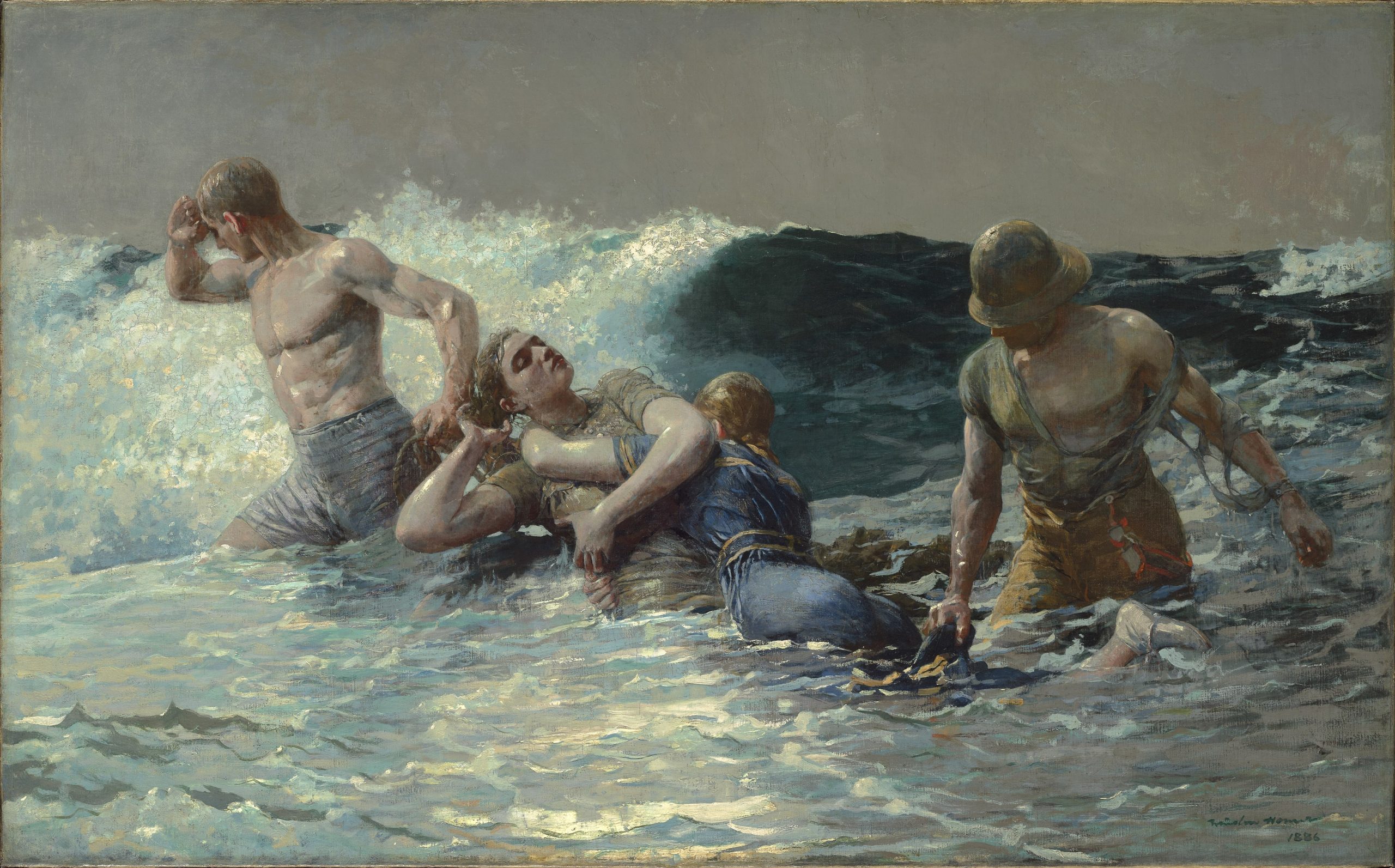
A Note About “Undertow” (The Clark Art Institute)
“In 1883, Homer witnessed an event near Atlantic City, New Jersey, that allegedly inspired this dramatic painting. Rescuers try to haul ashore two women, weighed down by their waterlogged bathing dresses, in danger of being pulled beneath the waves by an undertow. The figures appear as three-dimensional and solid as the ancient Greek marble statues on which they were modeled. Yet despite their muscularity and apparent strength, their struggle suggests human frailty in the face of the sea’s awesome power.”
“The World Is Too Much With Us” by William Wordsworth
The world is too much with us; late and soon,
Getting and spending, we lay waste our powers;—
Little we see in Nature that is ours;
We have given our hearts away, a sordid boon!
This Sea that bares her bosom to the moon;
The winds that will be howling at all hours,
And are up-gathered now like sleeping flowers;
For this, for everything, we are out of tune;
It moves us not. Great God! I’d rather be
A Pagan suckled in a creed outworn;
So might I, standing on this pleasant lea,
Have glimpses that would make me less forlorn;
Have sight of Proteus rising from the sea;
Or hear old Triton blow his wreathèd horn.
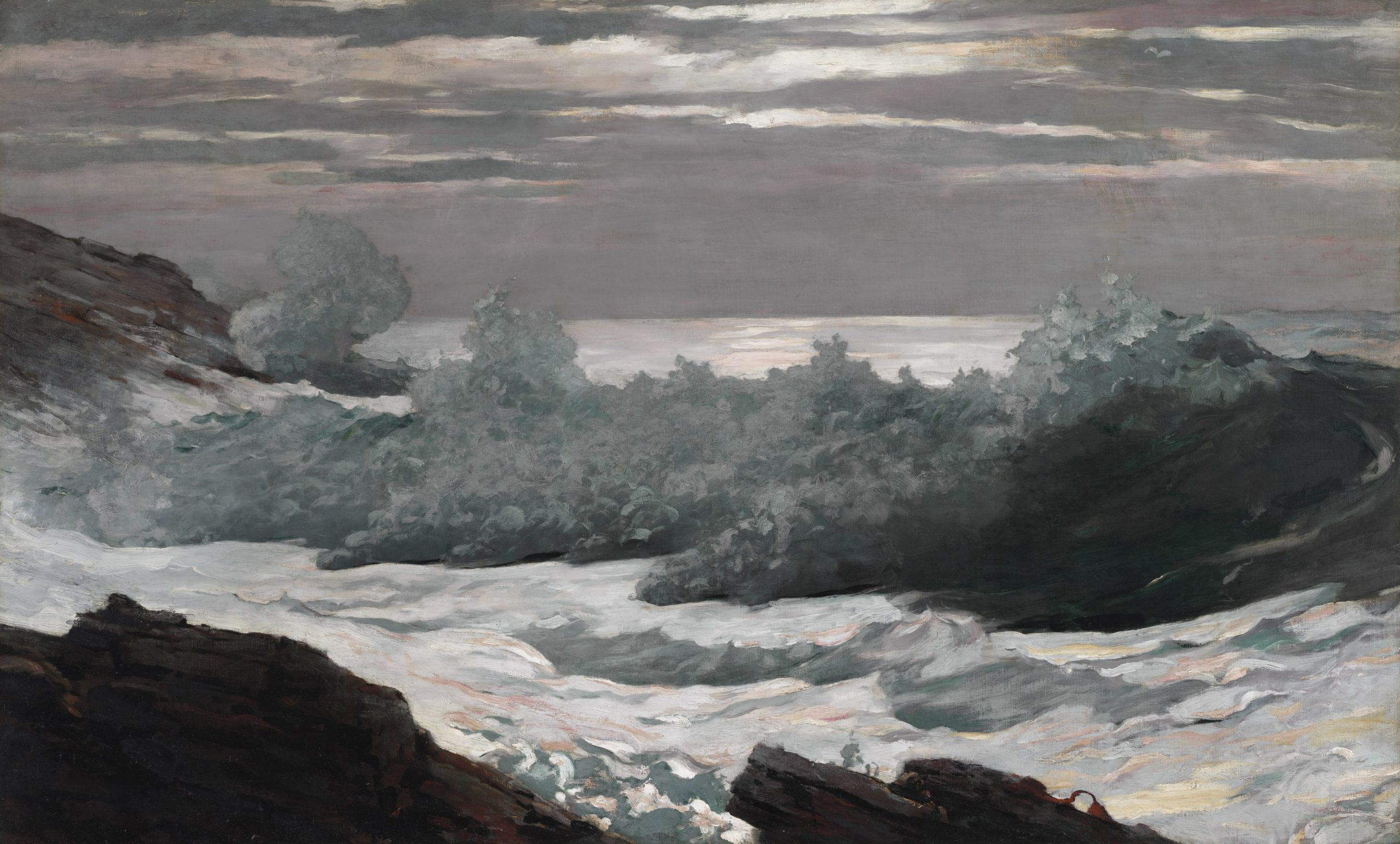
Courtesy: By Winslow Homer – https://clevelandart.org/art/1924.195, Public Domain, https://commons.wikimedia.org/w/index.php?curid=75975462
“Sea Grief” by Dowell O’Reilly
Along the serried coast the Southerly raves,
Grey birds scream landward through the distance hoar,
And swinging from the dim confounded shore,
The everlasting boom of broken waves.
Like muffled thunder rolls about the graves
Of all the wonder-lands and lives of your,
Whose bones asunder bleach for evermore,
In sobbing chasms and under choking caves.
O breaking heart—whose only rest is rage,
White tossing arms, and lips that kiss and part
In lonely dreams of love’s wild ecstasy.
Not the mean earth they suffering can assuage
Nor highest heaven fulfill thy hungry heart,
O fair full-bosomed passionate weeping sea.
From Favourite Poems of the Sea edited by Howard Watson (HarperCollins, 2015)
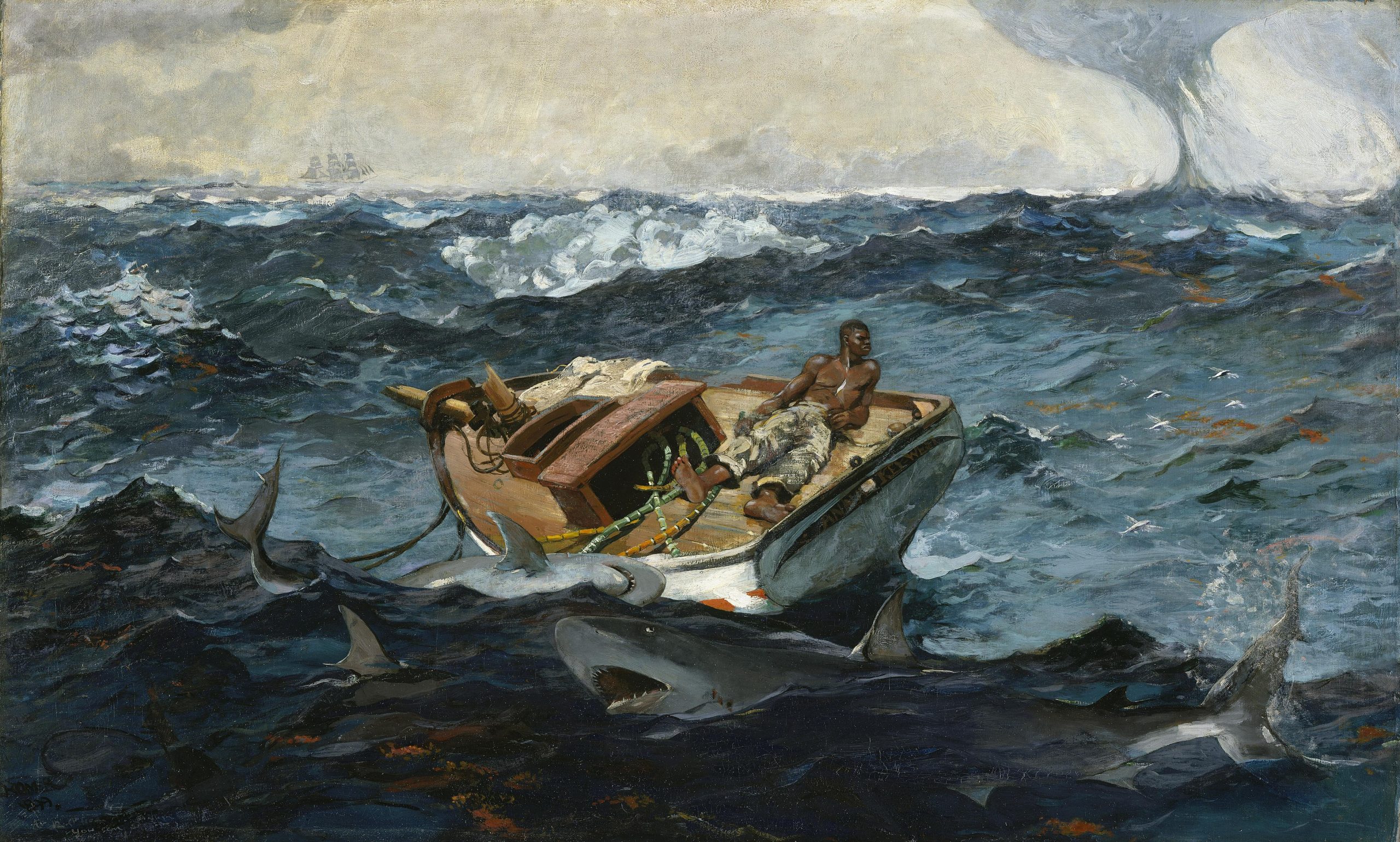
Courtesy: By Winslow Homer – art database, Public Domain, https://commons.wikimedia.org/w/index.php?curid=153005
A Note About “The Gulf Stream” (Metropolitan Museum of Art)
“[Winslow] Homer was preoccupied with the power of the ocean, and often made it the subject of his art, whether at home on the coast of Maine or while traveling. The Gulf Stream is named after the strong Atlantic current that connected many of the locales where he liked to paint. Homer based this dramatic scene of imminent disaster on sketches and watercolors he had made during winter trips to the Bahamas in 1884 and 1898, after crossing the Gulf Stream several times. A man faces his demise on a dismasted, rudderless fishing boat, sustained by only a few stalks of sugarcane, while threatened by sharks and a distant waterspout. He is oblivious to the schooner on the left horizon, which Homer later added to the composition as a sign of hopeful rescue. Painted shortly after the death of his father, in 1898, the painting has been interpreted as an expression of the artist’s presumed sense of mortality and vulnerability. The Gulf Stream also references some of the complex social and political issues of the era—war, the legacy of slavery, and American imperialism—as well as more universal concerns with the fragility of human life and the dominance of nature.”
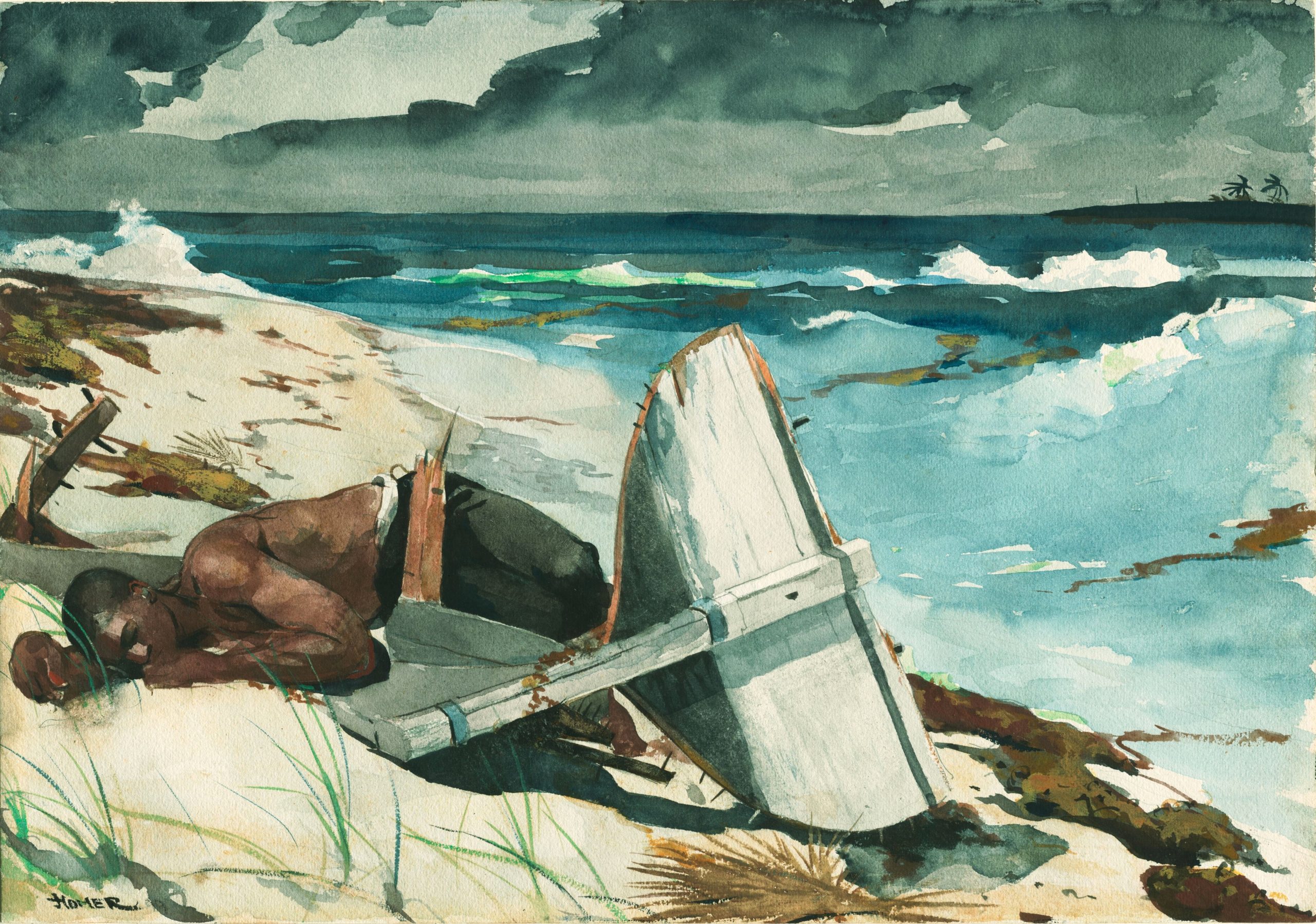
“The Ocean” by Nathaniel Hawthorne
The Ocean has its silent caves,
Deep, quiet, and alone;
Though there be fury on the waves,
Beneath them there is none.
The awful spirits of the deep
Hold their communion there;
And there are those for whom we weep,
The young, the bright, the fair.
Calmly the wearied seamen rest
Beneath their own blue sea.
The ocean solitudes are blest,
For there is purity.
The earth has guilt, the earth has care,
Unquiet are its graves;
But peaceful sleep is ever there,
Beneath the dark blue waves.
You can find The Complete Works of Nathaniel Hawthorne, With Introductory Notes by George Parsons Lathrop here.
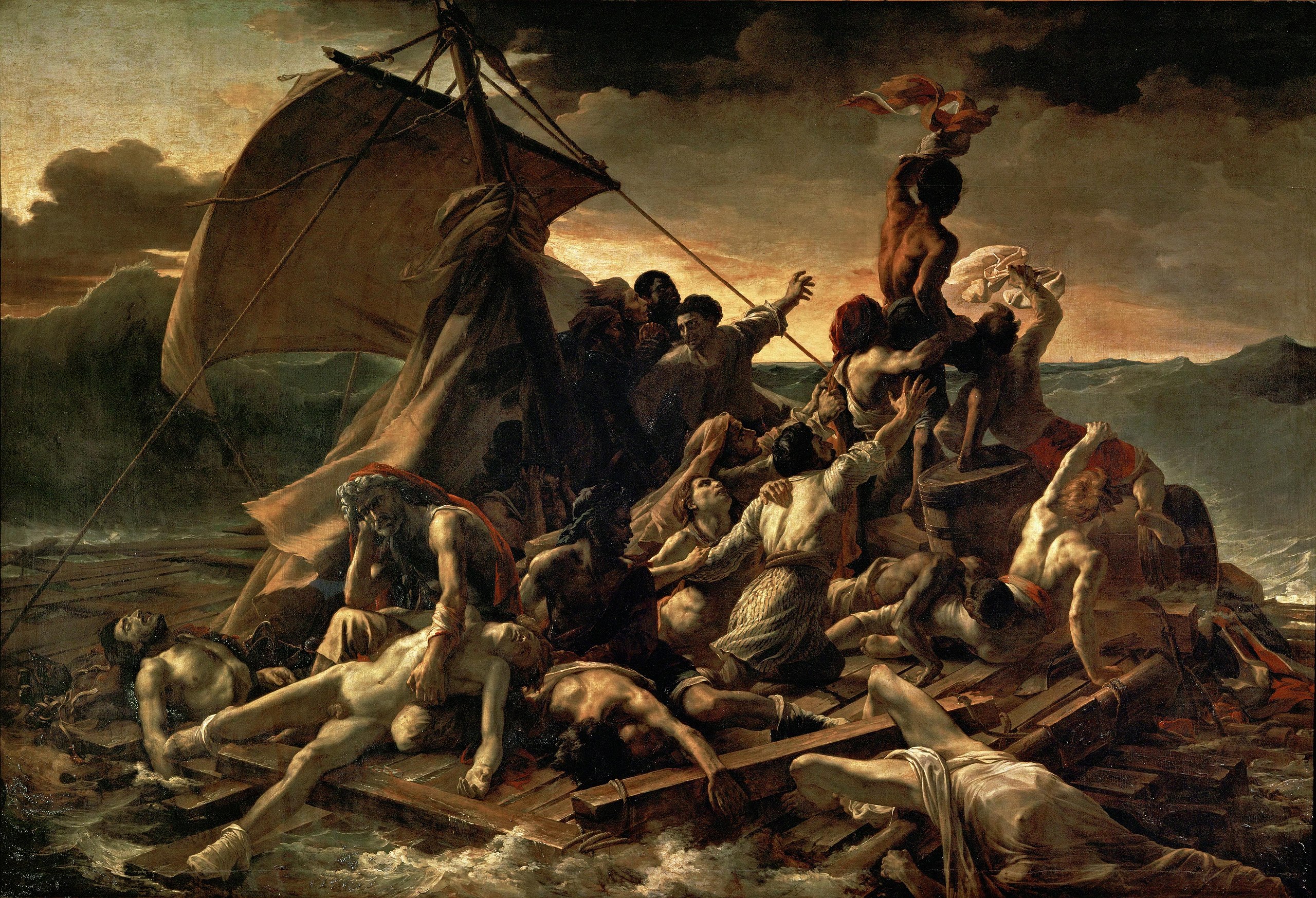
A Note About “The Raft of the Medusa” (Britannica)
“The Raft of the Medusa, painting (1819) by French Romantic artist Théodore Géricault depicting the survivors of a shipwreck adrift and starving on a raft. Géricault astonished viewers by painting, in harrowing detail, not an antique and noble subject but a recent gruesome incident.”
Images that Continue to Trouble and Haunt
How can we connect paintings from the past to current crises and global events? Theodore Gericault’s “The Raft of the Medusa” is a powerful and disturbing painting. Jonathan Jones writes that it is a painting that “calls for compassion, humanity, and common decency. … Darkness is literally eating up this painting … a deathly shadow seems to suck you into it. There is a black hole of horror at its heart” (The Guardian, August 11, 2015). We can consider the doomed fate of migrants forced to flee zones of conflict, war, and injustice throughout our world, including South and Central America, the Middle East, and Africa. Khaled Hosseini dedicates his book Sea Prayer to the thousands of people forced to flee violence. Alan Kurdi was a 2-year-old Syrian boy of Kurdish ethnic background who tragically drowned in the Mediterranean Sea along with his mother and brother. Hosseini’s poetic verses and provocative illustrations raise awareness about the tens of thousands of refugees who have perished at sea in recent decades in an effort to flee widespread conflict and war.
Reading Sea Prayer (2017) by Khaled Hosseini
Each day, individuals and families risk their lives on the sea in the hope of finding a safe haven and escape from oppressive regimes, war, and conflict. This journey is perilous and many lose their lives. The death of 2-year-old Alan Kurdi, whose body was found washed ashore in 2015, shocked many people and drew attention to the plight of refugees escaping war. The writer Khaled Hosseini is an Afghan-American novelist, UNHCR goodwill ambassador, and former physician. Beautifully illustrated, Khaled Hosseini’s Sea Prayer is written in the form of a letter to a son. He dedicated his book “to the thousands of refugees who have perished at sea fleeing war and persecution” (Introduction, Sea Prayer, 2017). The sea is an opportunity for escape but its vast expanse leaves individuals at the mercy of natural forces. The father narrating the prayer tries to reassure his son and protect him; however, he realizes the futility of his promise that “nothing bad will happen.” The father in Sea Prayer reflects upon the vast and indifferent expanse of the sea and the sense of hopelessness as he is unable to control the fate of his son. The father’s only option is to pray and hope that his son (“precious cargo”) will make it to land and safety.
Resources for Teaching Sea Prayer by Khaled Hosseini
You can find more information about the author Khaled Hosseini here.
A description of Sea Prayer can be found here.
More information about the death of Alan Kurdi can be found here.
“Rohingya Refugees Bet Lives on Boat Crossings Despite Rising Death Toll” by Shaikh Azizur Rahman and Rebecca Ratcliffe (The Guardian, 2023)
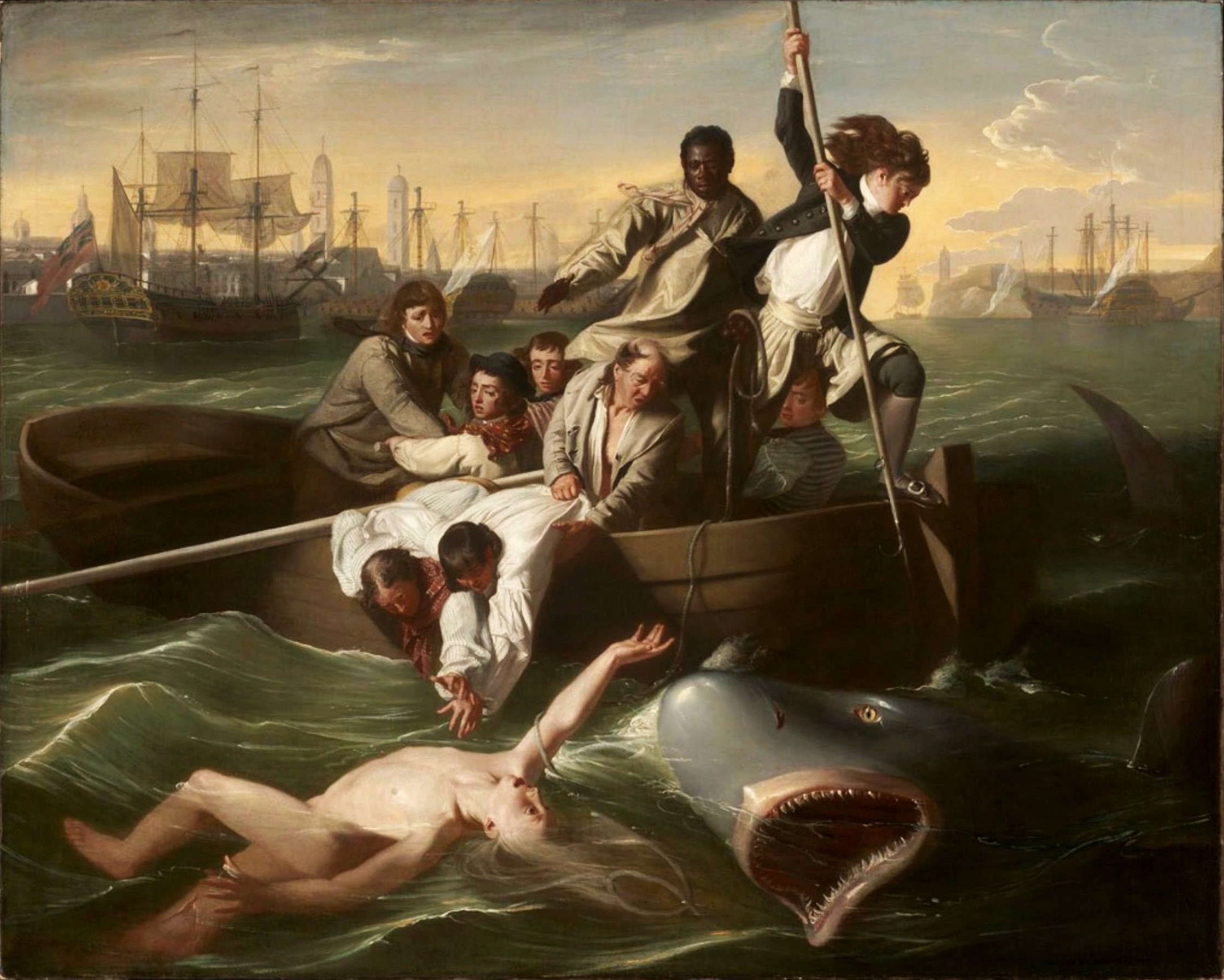
Courtesy: By John Singleton Copley – 1. Artchive.com2. Museum of Fine Arts, Boston, Public Domain, https://commons.wikimedia.org/w/index.php?curid=175517
A Note About “Watson and the Shark” (The Metropolitan Museum of Art)
“Copley painted this rapid study for “Watson and the Shark” from his first rendering of the iconic work—now in the National Gallery of Art, Washington—in preparation for successive versions, found in the collections of the Detroit Institute of Arts and the Museum of Fine Arts, Boston. It depicts the future Lord Mayor of London, Brook Watson, who, as a teenager, lost his leg to a shark while swimming in Havana harbor in 1749. A Black sailor forms the apex of the composition, holding a rope for the victim who later famously defended the slave trade in the West Indies. Copley’s dramatic depiction of an ordinary man in the midst of an extraordinary event of unresolved peril in the Atlantic World revolutionized British-American history painting.”
The Titanic Disaster
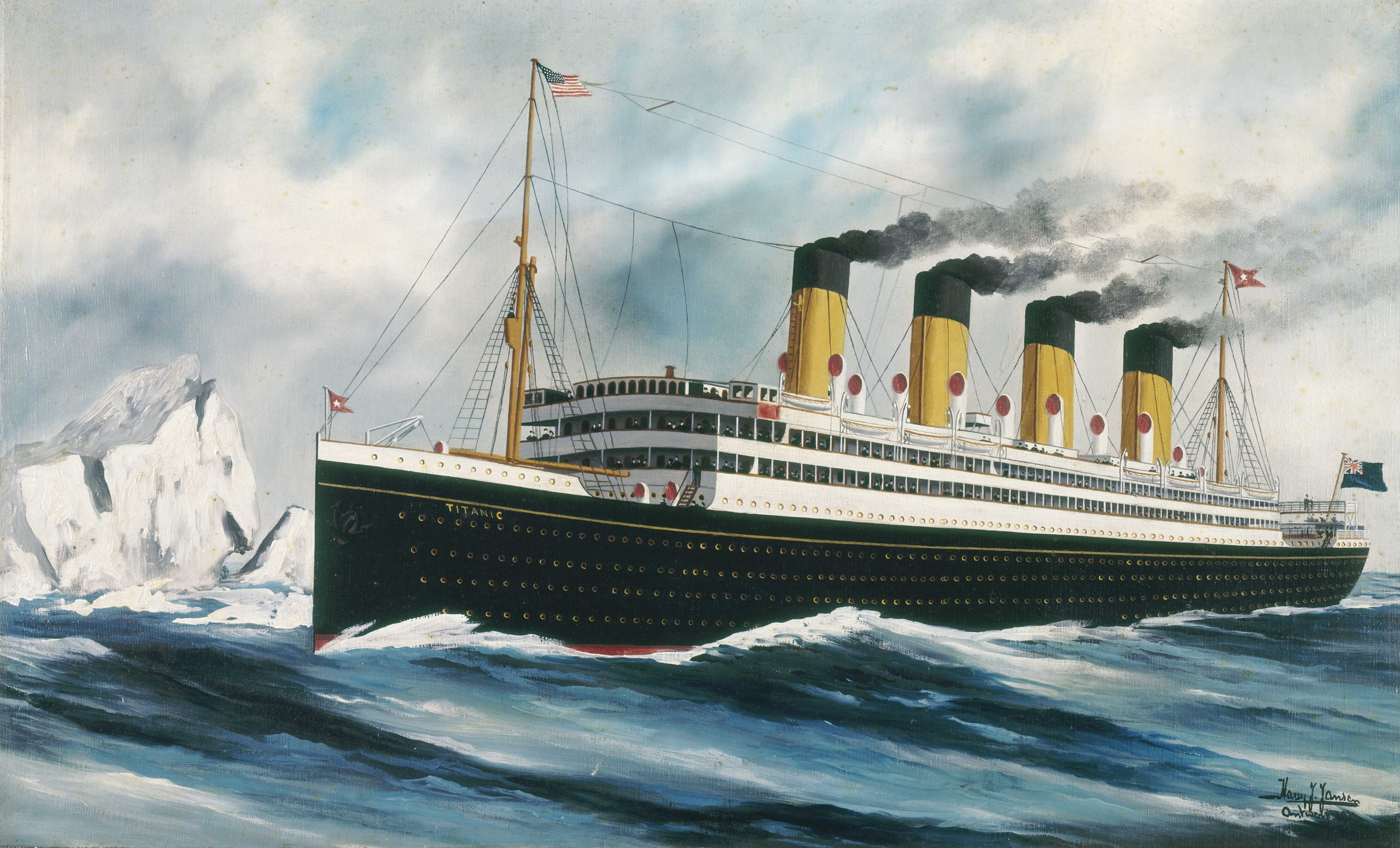
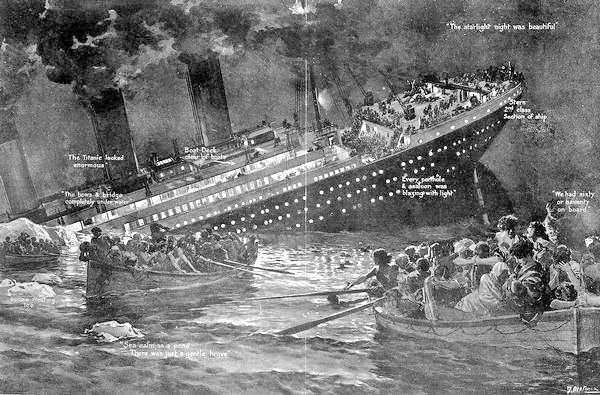
On April 14, 1912, four days after leaving Southampton, England, British luxury passenger liner the R.M.S. Titanic sank within 2 ½ hours after striking an iceberg off the coast of Newfoundland. This sea disaster claimed about 1,500 lives (passengers and ship personnel). There were insufficient numbers of life boats and the life boats that were launched were not full. Those who died in the icy North Atlantic had either drowned or died within minutes due to shock from the cold and incapacitation. Rescued by the Carpathia, there were 706 survivors (412 passengers and 214 crew members). The Titanic (named after the Titans of Greek mythology) was on her maiden voyage across the Atlantic.
Novels, stories, poems, musicals, and films continued to make the Titanic sinking one of the most famous tragedies in modern history. In 1955, Walter Lord wrote the non-fiction book A Night to Remember based on the Titanic disaster. Lord was one of the few writers to actually interview sixty-three survivors of the Titanic and he included their firsthand accounts in his book. His extensive research enabled readers to gain greater insights based on direct interviews.
Lord’s work continues to be of interest to historians, artists, and film makers today. A television adaptation of his book was narrated by the Austrian actor Claude Raines in 1956. In 1958, the book was the basis for a popular British film of the same name directed by Roy Baker and starring Kenneth More and David McCallum. Actors Kate Winslet and Leonardo DiCaprio starred in the 1997 blockbuster film version, titled Titanic. Irony, fate, love, drama, suspense, terror, and tragedy are interweaving themes that continue to draw interest in the Titanic. The wreck of the Titanic was found in 1985, four hundred nautical miles off the coast of Newfoundland.
“It becomes a haunting experience to me, it’s the haunting experience of ‘if only’.” – Walter Lord, Titanic historian and author of A Night to Remember (1955).
“The Titanic” by Aleister Crowley
Forth flashed the serpent streak of steel,
Consummate crown of man’s device;
Down crashed upon an immobile
And brainless barrier of ice.
Courage!
The grey gods shoot a laughing lip: –
Let not faith founder with the ship!
We reel before the blows of fate;
Our stout souls stagger at the shock.
Oh! there is Something ultimate
Fixed faster than the living rock.
Courage!
Catastrophe beyond belief
Harden our hearts to fear and grief!
The gods upon the Titans shower
Their high intolerable scorn;
But no god knoweth in what hour
A new Prometheus may be born.
Courage!
Man to his doom goes driving down;
A crown of thorns is still a crown!
No power of nature shall withstand
At last the spirit of mankind:
It is not built upon the sand;
It is not wastrel to the wind.
Courage!
Disaster and destruction tend
To taller triumph in the end.
Resources for Teaching the Titanic
National Geographic Titanic Resources.
“The Ship Titanic Sinks in the North Atlantic: Teaching with Primary Sources” (PBS Learning Media)
“Walter Lord, Narrative Historian, Dies at 84” by Albin Krebs (The New York Times, 2002)
A Night to Remember by Walter Lord (Bantam Books, 1997)
More information about A Night to Remember can be found here.
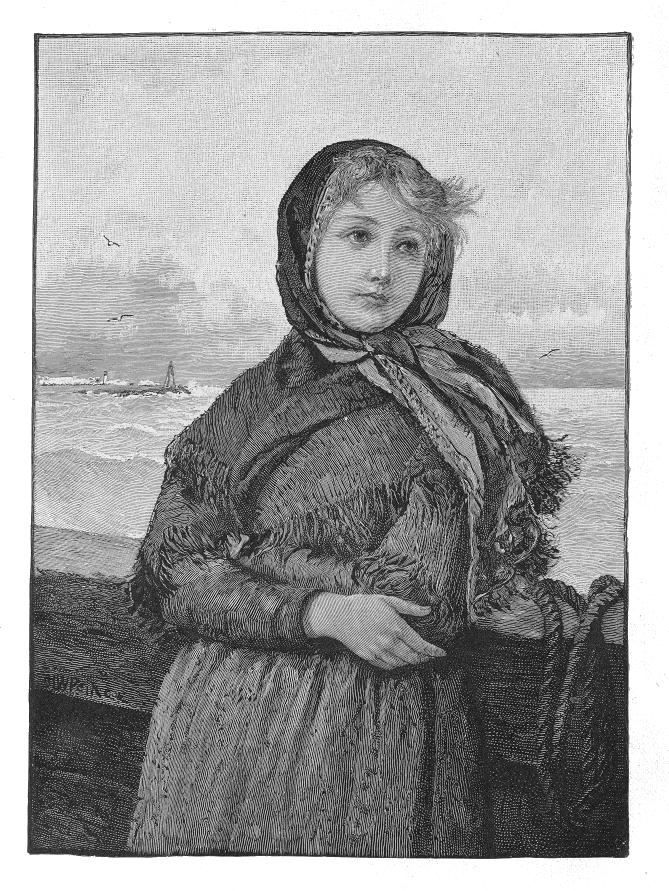
The Wreck of the Hesperus
The sea as a life-giving force can also be deadly. Henry Wadsworth Longfellow wrote this memorable poem/ballad based on a shattering 1830 blizzard that hit the east coast of North America. There were accounts of 1000 ships lost and over 40,000 lives lost. Longfellow may have been inspired to write this poem based on the incidents from the main ship, the Favorite. One one woman survived by all accounts and she washed upon the shore still bound to the mast. Ocean travel with all its moments of mystery, beauty, and awe also held tragedy.
To read more about the Hesperus please open the link here.
“The Wreck of the Hesperus” by Henry Wadsworth Longfellow
It was the schooner Hesperus,
That sailed the wintry sea;
And the skipper had taken his little daughtèr,
To bear him company.
Blue were her eyes as the fairy-flax,
Her cheeks like the dawn of day,
And her bosom white as the hawthorn buds,
That ope in the month of May.
The skipper he stood beside the helm,
His pipe was in his mouth,
And he watched how the veering flaw did blow
The smoke now West, now South.
Then up and spake an old Sailòr,
Had sailed to the Spanish Main,
“I pray thee, put into yonder port,
For I fear a hurricane.
“Last night, the moon had a golden ring,
And to-night no moon we see!”
The skipper, he blew a whiff from his pipe,
And a scornful laugh laughed he.
Colder and louder blew the wind,
A gale from the Northeast,
The snow fell hissing in the brine,
And the billows frothed like yeast.
Down came the storm, and smote amain
The vessel in its strength;
She shuddered and paused, like a frighted steed,
Then leaped her cable’s length.
“Come hither! come hither! my little daughtèr,
And do not tremble so;
For I can weather the roughest gale
That ever wind did blow.”
He wrapped her warm in his seaman’s coat
Against the stinging blast;
He cut a rope from a broken spar,
And bound her to the mast.
“O father! I hear the church-bells ring,
Oh say, what may it be?”
“‘T is a fog-bell on a rock-bound coast!” —
And he steered for the open sea.
“O father! I hear the sound of guns,
Oh say, what may it be?”
“Some ship in distress, that cannot live
In such an angry sea!”
“O father! I see a gleaming light,
Oh say, what may it be?”
But the father answered never a word,
A frozen corpse was he.
Lashed to the helm, all stiff and stark,
With his face turned to the skies,
The lantern gleamed through the gleaming snow
On his fixed and glassy eyes.
Then the maiden clasped her hands and prayed
That savèd she might be;
And she thought of Christ, who stilled the wave
On the Lake of Galilee.
And fast through the midnight dark and drear,
Through the whistling sleet and snow,
Like a sheeted ghost, the vessel swept
Tow’rds the reef of Norman’s Woe.
And ever the fitful gusts between
A sound came from the land;
It was the sound of the trampling surf
On the rocks and the hard sea-sand.
The breakers were right beneath her bows,
She drifted a dreary wreck,
And a whooping billow swept the crew
Like icicles from her deck.
She struck where the white and fleecy waves
Looked soft as carded wool,
But the cruel rocks, they gored her side
Like the horns of an angry bull.
Her rattling shrouds, all sheathed in ice,
With the masts went by the board;
Like a vessel of glass, she stove and sank,
Ho! ho! the breakers roared!
At daybreak, on the bleak sea-beach,
A fisherman stood aghast,
To see the form of a maiden fair,
Lashed close to a drifting mast.
The salt sea was frozen on her breast,
The salt tears in her eyes;
And he saw her hair, like the brown sea-weed,
On the billows fall and rise.
Such was the wreck of the Hesperus,
In the midnight and the snow!
Christ save us all from a death like this,
On the reef of Norman’s Woe!
Tragedies at Sea
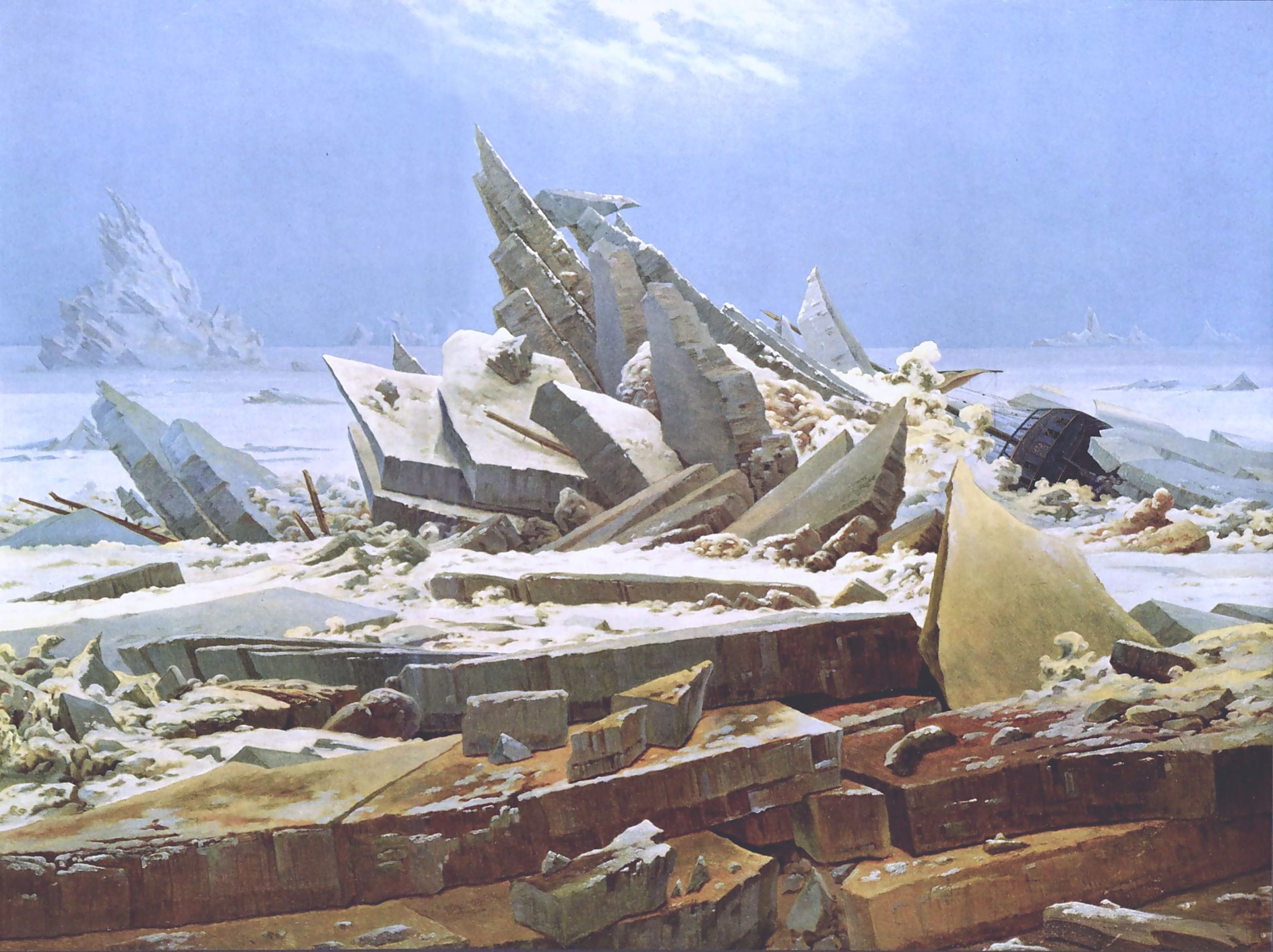
“Fire and Ice” by Robert Frost
Some say the world will end in fire,
Some say in ice.
From what I’ve tasted of desire
I hold with those who favor fire.
But if it had to perish twice,
I think I know enough of hate
To say that for destruction ice
Is also great….
Excerpt from “The Cold Earth Slept Below” by Percy Bysshe Shelley
The cold earth slept below;
Above the cold sky shone;
And all around,
With a chilling sound,
From caves of ice and fields of snow
The breath of night like death did flow
Beneath the sinking moon….
You can find more poems by Robert Frost here.
Polar Bears
Excerpt from “Introduction to the Polar Bears of Churchill” (Churchill Northern Studies Centre)
“Discrete populations of polar bears are found throughout ice-covered waters of the circumpolar Arctic. In Canada, there are 13 populations, totaling approximately 15, 000 bears. Polar bears are largely marine animals, preferring to remain on the sea ice where they hunt their main prey of seals. They feed primarily on ringed seals although bears will also eat bearded seals and occasionally walruses, beluga whales and narwhals. In many areas of the arctic, they are able to hunt on the ice year-round. It is only in areas where the ice melts in the summer, like southwestern Hudson Bay, that the bears are forced ashore until the ice refreezes in the fall.”
You can find more information about the polar bears of Churchill, Manitoba here.
You can read more information about Canadian artist and activist Kal Barteski here.
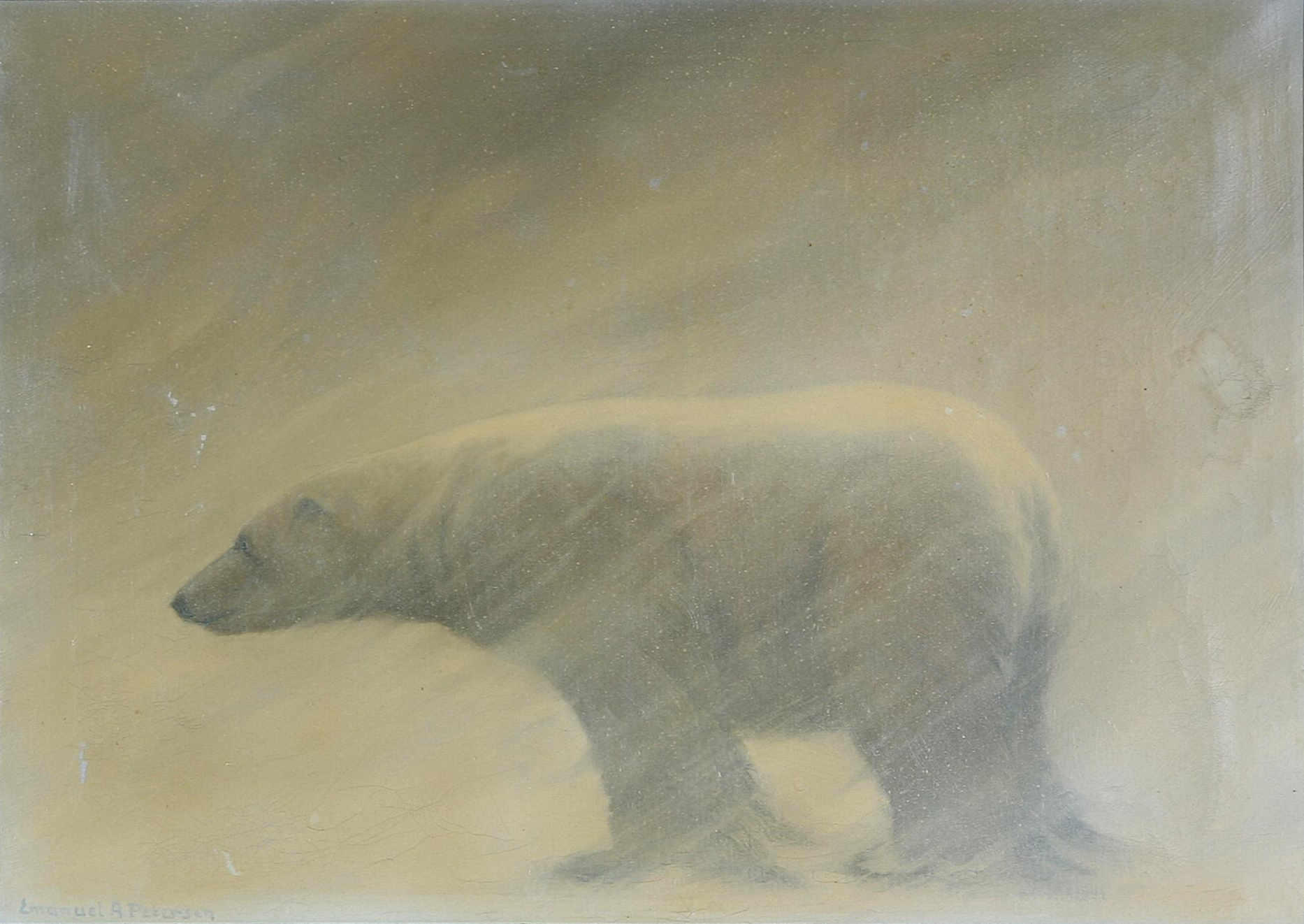
Excerpt from “Polar Bear” by Nicholas J. Lunn (Canadian Encyclopedia, 2012)
“The polar bear (Ursus maritimus) is the largest living species of bear. They are found throughout the circumpolar Arctic. In Canada, this means polar bears live in parts of the Yukon, the Northwest Territories, Nunavut, Manitoba,Ontario, Quebec and Newfoundland and Labrador. Polar bears are both culturally and economically significant to the Inuit. As climate change continues to reduce their sea ice habitat, polar bears are increasingly threatened.”
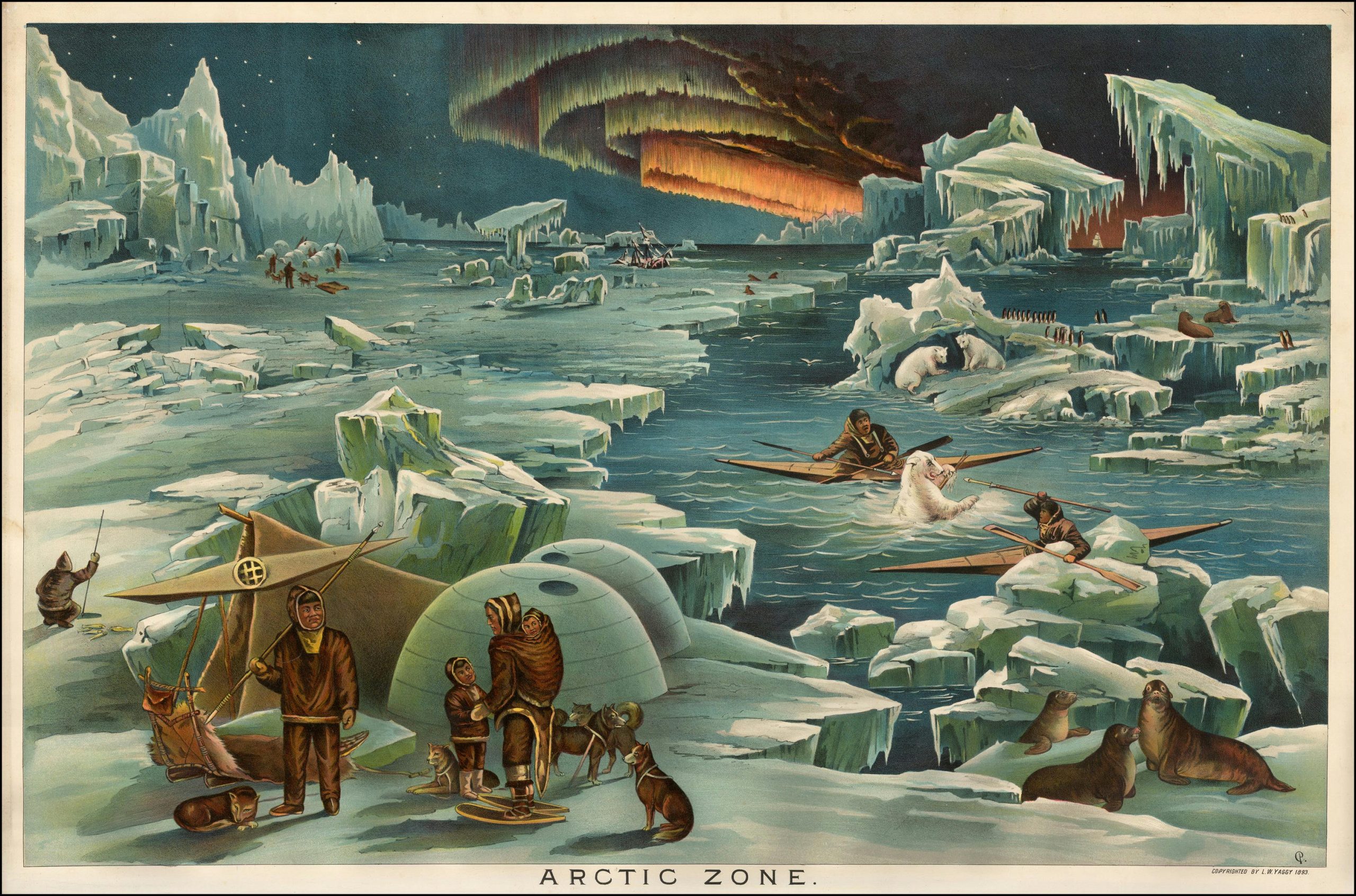
Polar Seas
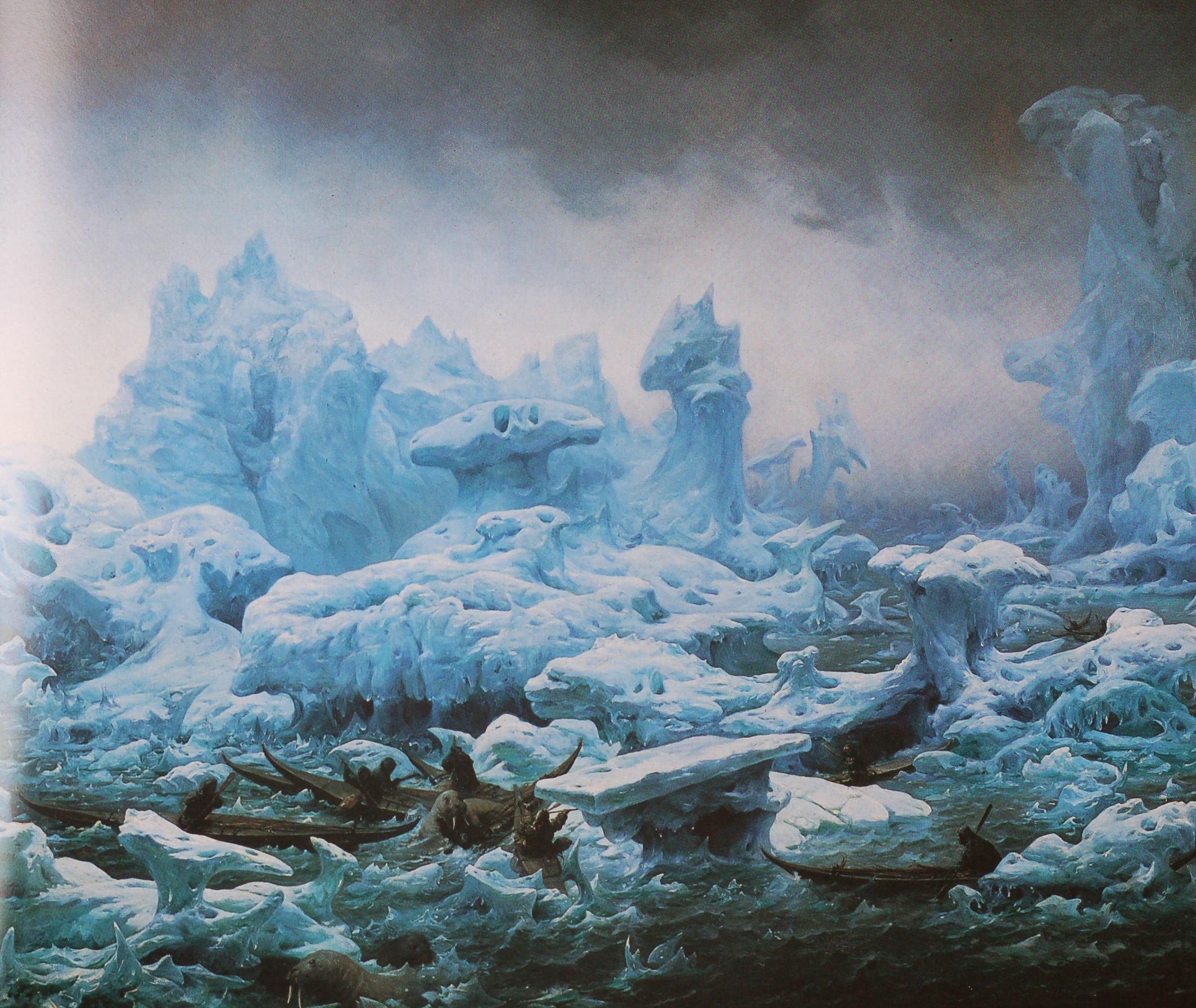
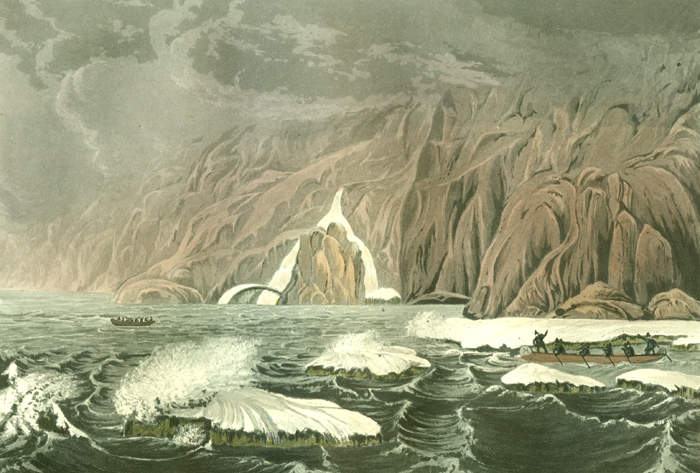
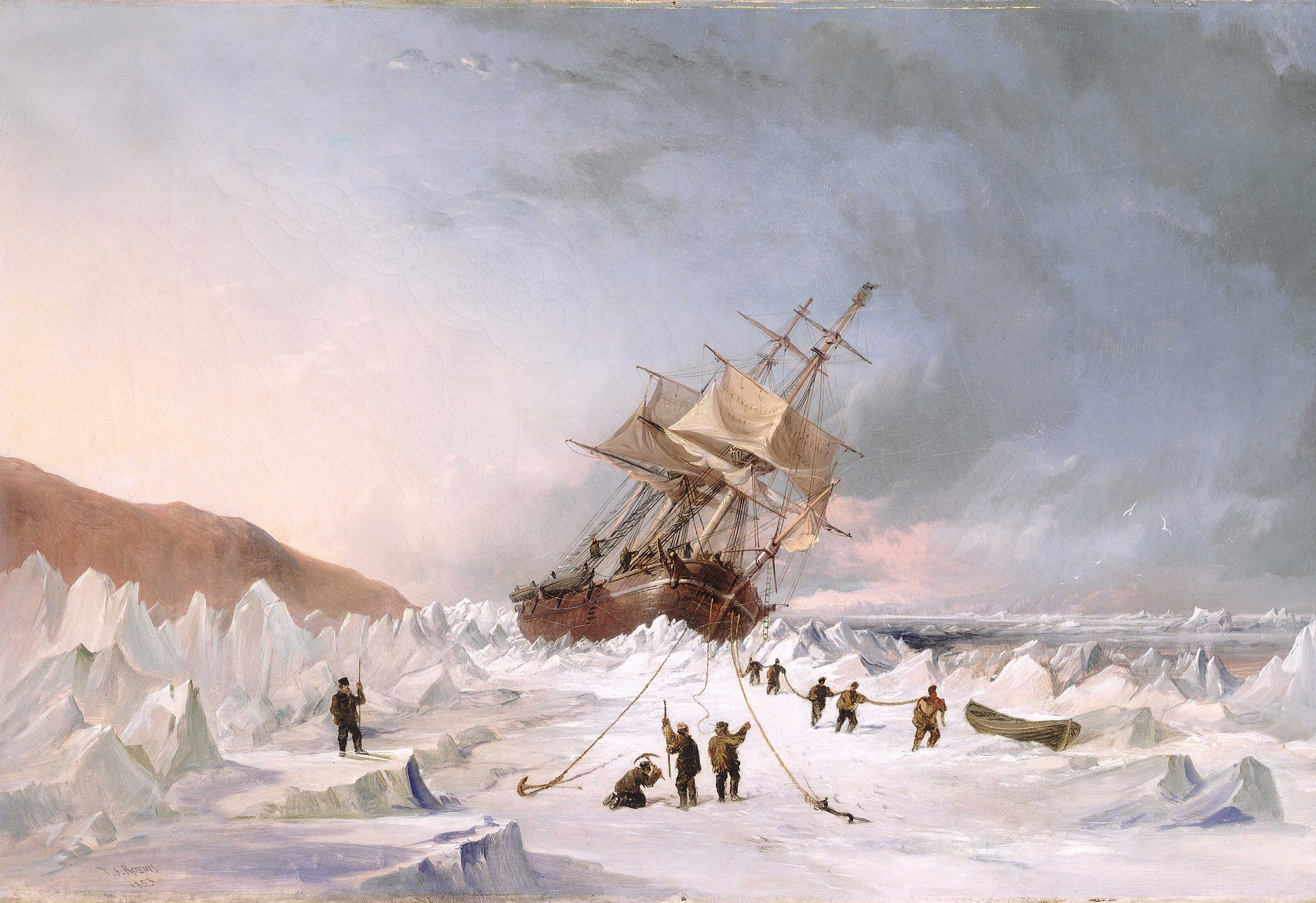
Further Resources:
“The Arctic” (National Geographic Society)
“The Changing Arctic Landscape” (PBS Learning Media)
“Top 10 Arctic Novels” by Ian McGuire (The Guardian, 2016)
“10 Books About the Arctic” by Sophia LeFevre (Book Riot, 2019)
A Note About “Whalers” (The Metropolitan Museum of Art)
J.M. Turner was seventy years old when Whalers debuted to mixed reviews at the Royal Academy exhibition of 1845. Its subject proved elusive, as the English novelist William Thackeray observed: “That is not a smear of purple you see yonder, but a beautiful whale, whose tail has just slapped a half-dozen whale-boats into perdition; and as for what you fancied to be a few zig-zag lines spattered on the canvas at hap-hazard, look! they turn out to be a ship with all her sails.” Apparently Turner undertook the painting—which was returned to him—for the collector Elhanan Bicknell, who had made his fortune in the whale-oil business.”
You can find more information about Joseph Mallord William Turner’s seascapes here.
“Calais Pier” by J.M. Turner

